Walking Tours
Home Page
Cabrillo National Monument
a walking tour by Carol Mendel
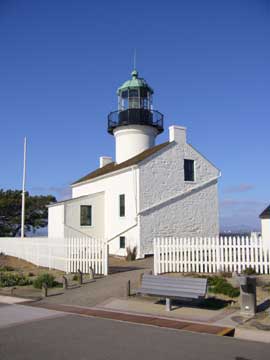
|
Cabrillo National Monument is administered by the National Park Service. Its unsurpassed beauty, coupled with its easy accessibility, probably explains why nearly a million visitors come here every year.
The main walking tour takes you through the area around the visitor center, up to the Old Point Loma Lighthouse, and then to the whale-watching station.
Distance: A half mile. Time: An hour.
A separate, more strenuous, walk follows the Bayside Trail, winding down the bay side of Point Loma. It offers the opportunity to see some fortifications remaining from World War II, and to learn about some of the plants and animals native to the Southern California coast.
MAP of the walking tour
Terms of Use
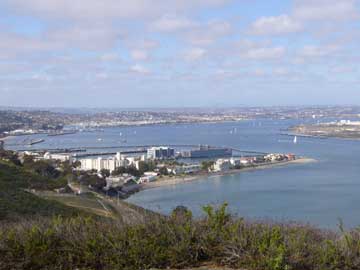
|
Walk a few feet to the right. A series of plaques help you to identify the variety of pleasure craft, merchant ships, and Navy ships you may see on the water, plus the types of planes and helicoters you may see in the air.
Another plaque shows the major geographical features of the San Diego area, ranging from Mexico north to Mount Soledad.
Now walk between the buildings and across the patio to the exhibit hall, where you will find exhibits about Cabrillo and other Spanish explorers who forged paths across the New World.
Next door to the exhibits is the auditorium. Here the National Park Service shows half-hour films, including "In Search of Cabrillo," about Cabrillo, "On the Edge of Land and Sea," about the tide pools, and "Whales," about the natural history and annual migration of the Pacific Gray Whale. Check the posted list outside the auditorium for the schedule of film titles and showing times.
On the other side of the auditorium is a native plant garden, with information about the coastal scrub plants that live in this area. The Park Service has adopted a program of removing non-native plants and replacing them with native ones, so you will see a lot of these native plants as you take these walks.
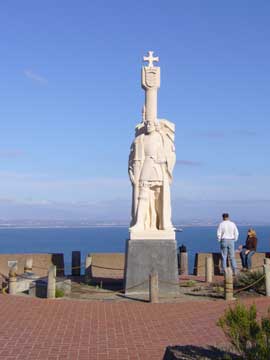
|
Retrace your steps back to the road, then walk to the left along a sidewalk that leads up to the Old Point Loma Lighthouse. The lighthouse first sent its beam out to ships in 1855, five years after California joined the Union. Unfortunately, however, the beam didn't always reach the ships -- the light was 462 feet above sea level and often obscured by low clouds. Hence 36 years later, in 1891, the government built a new lighthouse, still in use, at sea level at the base of Point Loma. The original lighthouse fell into disrepair, but now has been restored to reflect the way it was in 1887.
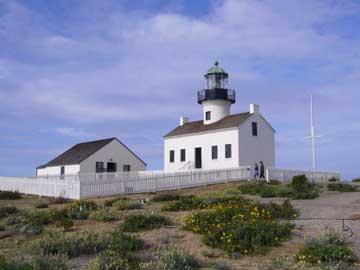
|
When you finish, walk between the two buildings, pass the kitchen garden, and turn left at the concrete walkway. You can now enjoy a view of the Pacific Ocean as you make your way south to Whale Overlook.
Every winter the Gray Whales migrate from the Bering Sea and the Chukchi Sea, between Alaska and Siberia, to their breeding grounds in the warm, shallow lagoons of Baja California and mainland Mexico. As late as the 1800's, female whales calved in San Diego Bay as well, which partly explains why whaling was a significant San Diego enterprise in the second half of the 19th Century.
Whale-watching is a popular sport in San Diego, and Cabrillo National Monument is one of the best land-based spots to see them. If you come between mid-December and the end of February, you will probably be able to see a few of the huge mammals on their journey south. (For a close-up and exciting view of the whales, you should take one of the whale-watching excursion boats that leave from Shelter Island or Mission Bay.) Whale Overlook contains a series of plaques featuring the Gray Whale, Point Loma, and coastal marine life.
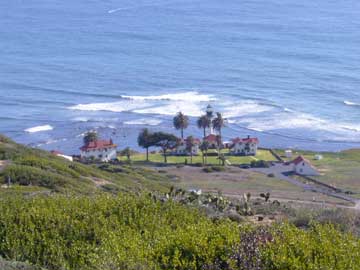
|
Return to top.
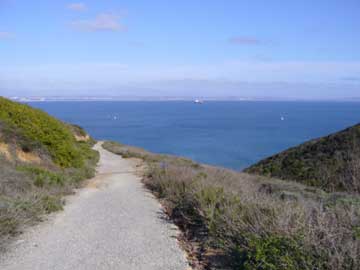
|
Distance: Two miles, including return. Time: One and a half hours.
This side trip begins at a well-marked road near the east side of the lighthouse. It is particularly delightful in April and May, when many of the plants of this coastal sage scrub community are in bloom. Excellent interpretive signs along the trail enhance your experience.
Please remember that all plants and animals here are protected. You are not permitted to pick any of the flowers or remove any of the plants.
As you begin down the road, you have a beautiful view of San Diego Bay on your left. Especially on weekends, you will find the entrance to the bay dotted with the white sails of dozens of sailboats.
On your right you will see the lemonadeberry shrub. You will see many of these plants along the trail. Recognize the lemonadeberry (Rhus integrifolia) by its leathery, stiff, and sometimes toothed, leaves. In the spring, it sports pink blossoms, which later become sticky, red-orange fruits with a lemonish flavor.
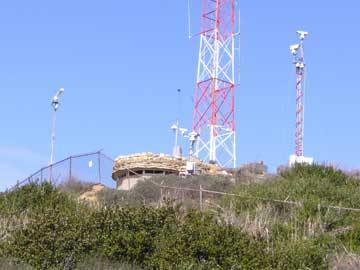
|
Continue down the road and soon a trail leads off to the left while the road continues south to some military installations.
Take the trail.

|
After a while, and near a bench, you will come to a concrete box with a green metal door. During World War II, a searchlight was plugged in here and used to watch who was coming into or out of the bay.
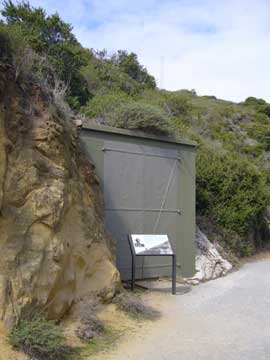
|
The trail continues around a few more bends and ends below the Cabrillo Statue Overlook. You then return by the way you came.
Return to top.
|
Enjoy this walking tour?
Check out the others in this series Balboa Park Cabrillo National Monument Downtown San Diego The Embarcadero La Jolla La Playa Mission Bay Park Mission Beach Old Town Shelter Island Sunset Cliffs |
Enjoy full-color illustrated maps? Check out the ones below. Some can be purchased as laminated maps, some as folded maps, some as wooden trays, and some as all three. San Diego Los Angeles Palm Springs Santa Barbara San Francisco Bay Area Las Vegas Salt Lake City Oregon Washington DC |